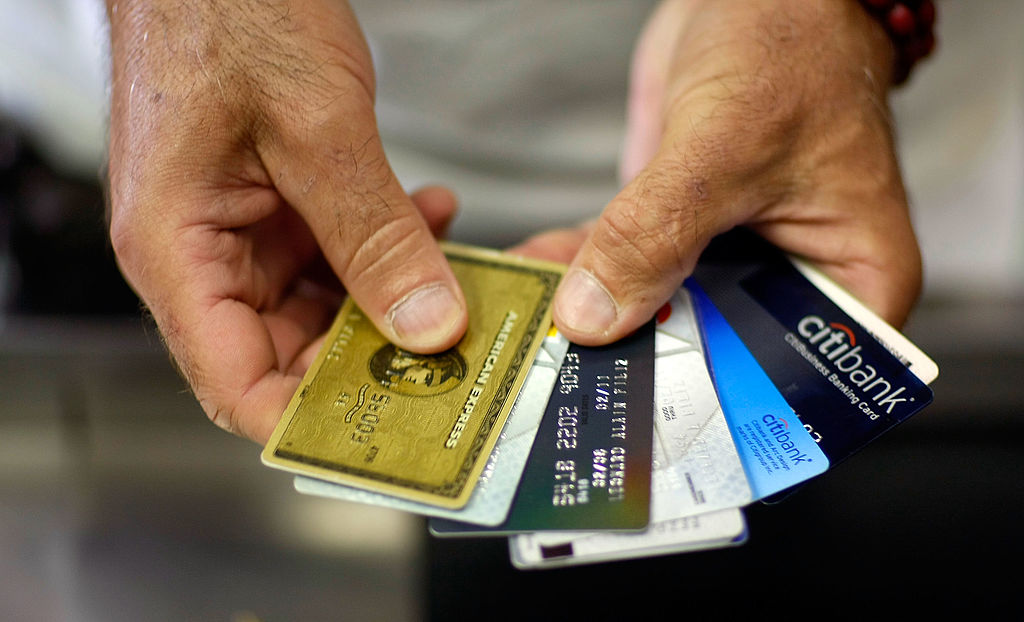Some Banks Want To Consign Credit Card Interest To History
Australian lenders hope no-interest cards can arrest a decline in usage and attract younger customers.
Interest charges have been one of the defining features of credit cards for decades and so when an employee at a big Australian bank suggested getting rid of them, he was taking a risk.
“He said, ‘Well, what about a no-interest credit card?’ ” said Rachel Slade, personal banking group executive at National Australia Bank Ltd., recalling a feedback session at one of the lender’s Melbourne offices. “And everyone’s like, ‘What? That’s not how a credit card works.’ ”
Worried about dwindling credit-card usage during the coronavirus pandemic and the rapid rise of startups like Australia’s Afterpay Ltd. and Sweden’s Klarna Bank AB that allow consumers to pay for goods in instalments, some banks are rethinking what has been one of their most lucrative businesses.
National Australia Bank, known locally as NAB, launched a no-interest credit card in September. Users get a fixed line of credit and the bank levies a monthly fee, which is refunded if the customer maintains a zero balance and doesn’t use the card. Commonwealth Bank of Australia, the country’s largest lender by market value, also unveiled a no-interest card last year.
The experiment isn’t being replicated in the U.S. where most credit-card issuers charge interest when cardholders carry balances. But if they prove to be successful, Australian banks’ no-interest cards could drive change in other markets.
Fees on the cards offered by NAB and CBA vary according to credit limits. For example, a balance of $1000 Australian dollars on CBA’s no-interest card could accrue nearly $484 in fees over 40 months if there is an outstanding balance each month. The same balance on the NAB card repaid at that product’s minimum rate would cost about $292 over 29 months.
In both cases, that is more than the interest accrued by a customer making the same repayments on a regular card with a 16.6% annual percentage rate, the typical rate in Australia. And like with other cards, customers are required to make minimum monthly repayments on any outstanding balances.
Still, the banks are betting that consumers will like the products for their simplicity. No-interest cards are designed to give customers more control over their spending via a product that is easy to understand, said Angus Sullivan, CBA’s group executive of retail banking services.
According to Australia’s central bank, the country’s credit and charge card balances fell by almost 34% in the two years through October to the equivalent of $21.17 billion. More than 60% of the decline came in March and October last year as the pandemic pushed Australia’s economy into recession.
Over the same period, debit-card transactions locally grew by 4.7% in number and by 5.6% in value, to hit more than the equivalent of nearly $33 billion.
Some analysts view the no-interest cards as a salvo in an intensifying battle for share of the payments market between banks with large credit-card businesses and buy now, pay later providers like Afterpay and Zip Co.
In Australia, buy-now-pay-later services don’t need to verify income or check existing debts held by users, which makes it easier for consumers to gain access to those products than a traditional credit card.
According to their most recent half-yearly filings, Afterpay and Zip respectively count 14% and 9% of Australia and New Zealand’s combined adult populations as customers. The average age of the 3.3 million Australians and New Zealanders using Afterpay at the end of June was 35 and 33, respectively.
Ms Slade said NAB’s no-interest card aims to attract younger customers who don’t necessarily have strong ties to the bank, illustrating a broad concern among traditional lenders that they are losing out in the battle for millennials.
In the three months since launch, the StraightUp card was among NAB’s three most popular credit cards among new applicants. Demand was strongest among customers under 40 years old, the bank said.
Tom Beadle, an analyst at UBS Group AG, said it is unlikely that no-interest credit cards in Australia will be a material threat to the buy now, pay later sector. This is because the consumer still needs to pay for the cards through upfront fees of up to $22 a month.
In contrast, buy now, pay later services often charge no interest and are generally free to users who make payments on time. A survey published by UBS in October found that most buy now, pay later users valued the payment method because it helped them to budget and they considered it convenient.
“The whole beauty of Afterpay is that it’s just really simple: It’s free,” Mr Beadle said. “People just want simplicity, and Afterpay have absolutely nailed that.”
Afterpay and Zip have made no secret that they intend to challenge credit-card providers. In August, Zip said the credit card industry was fundamentally broken, citing high revolving interest, confusing terms, a lack of trust and an absence of brand loyalty that had accelerated a structural decline in usage.
Four years after its debut on Australia’s stock market with a market value of $149 million, Afterpay is now worth US$32.7 billion. Afterpay and Zip are also expanding in the U.S., recording a combined A$7.4 billion Australian dollars in transactions on their networks in the six months through June.
Still, the UBS survey, based on 1,000 respondents, found a “not insignificant proportion” of users appear to regard buy now, pay later as a line of credit. Some 25% of users said they couldn’t afford a product with their existing savings, while 12% said they couldn’t get approval for a credit card.
Australia’s experience could offer lessons to the U.S., where lenders are also seeing a decline in credit-card usage and growth in debit-card usage, although it will take time before banks can be sure no-interest cards are popular.
Credit reporting firm Experian PLC said that U.S. consumer credit card debt in 2020 contracted for the first time in eight years. After hitting a record high of US$829 billion in 2019, balances decreased by 9% in the past year.
At Visa Inc. and Mastercard Inc., U.S. debit-card dollar payment and purchase volume collectively rose 23% year-over-year in the quarter ended in September, more than double the pre-Covid-19 growth rate; the same measure for credit cards was down 8%.
Some American credit-card issuers are seeking to slow the buy now, pay later industry’s growth in other ways. Late last year, Capital One Financial Corp. stopped their cards from being used to make Afterpay purchases and payments, the Australian company said.
 Copyright 2020, Dow Jones & Company, Inc. All Rights Reserved Worldwide. LEARN MORE
Copyright 2020, Dow Jones & Company, Inc. All Rights Reserved Worldwide. LEARN MORE
This stylish family home combines a classic palette and finishes with a flexible floorplan
Just 55 minutes from Sydney, make this your creative getaway located in the majestic Hawkesbury region.
Continued stagflation and cost of living pressures are causing couples to think twice about starting a family, new data has revealed, with long term impacts expected
Australia is in the midst of a ‘baby recession’ with preliminary estimates showing the number of births in 2023 fell by more than four percent to the lowest level since 2006, according to KPMG. The consultancy firm says this reflects the impact of cost-of-living pressures on the feasibility of younger Australians starting a family.
KPMG estimates that 289,100 babies were born in 2023. This compares to 300,684 babies in 2022 and 309,996 in 2021, according to the Australian Bureau of Statistics (ABS). KPMG urban economist Terry Rawnsley said weak economic growth often leads to a reduced number of births. In 2023, ABS data shows gross domestic product (GDP) fell to 1.5 percent. Despite the population growing by 2.5 percent in 2023, GDP on a per capita basis went into negative territory, down one percent over the 12 months.
“Birth rates provide insight into long-term population growth as well as the current confidence of Australian families,” said Mr Rawnsley. “We haven’t seen such a sharp drop in births in Australia since the period of economic stagflation in the 1970s, which coincided with the initial widespread adoption of the contraceptive pill.”
Mr Rawnsley said many Australian couples delayed starting a family while the pandemic played out in 2020. The number of births fell from 305,832 in 2019 to 294,369 in 2020. Then in 2021, strong employment and vast amounts of stimulus money, along with high household savings due to lockdowns, gave couples better financial means to have a baby. This led to a rebound in births.
However, the re-opening of the global economy in 2022 led to soaring inflation. By the start of 2023, the Australian consumer price index (CPI) had risen to its highest level since 1990 at 7.8 percent per annum. By that stage, the Reserve Bank had already commenced an aggressive rate-hiking strategy to fight inflation and had raised the cash rate every month between May and December 2022.
Five more rate hikes during 2023 put further pressure on couples with mortgages and put the brakes on family formation. “This combination of the pandemic and rapid economic changes explains the spike and subsequent sharp decline in birth rates we have observed over the past four years,” Mr Rawnsley said.
The impact of high costs of living on couples’ decision to have a baby is highlighted in births data for the capital cities. KPMG estimates there were 60,860 births in Sydney in 2023, down 8.6 percent from 2019. There were 56,270 births in Melbourne, down 7.3 percent. In Perth, there were 25,020 births, down 6 percent, while in Brisbane there were 30,250 births, down 4.3 percent. Canberra was the only capital city where there was no fall in the number of births in 2023 compared to 2019.
“CPI growth in Canberra has been slightly subdued compared to that in other major cities, and the economic outlook has remained strong,” Mr Rawnsley said. “This means families have not been hurting as much as those in other capital cities, and in turn, we’ve seen a stabilisation of births in the ACT.”
This stylish family home combines a classic palette and finishes with a flexible floorplan
Just 55 minutes from Sydney, make this your creative getaway located in the majestic Hawkesbury region.






















